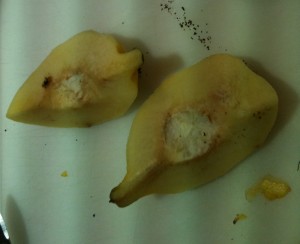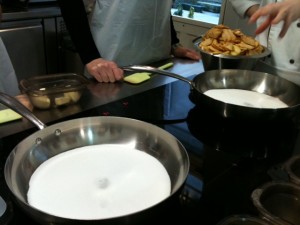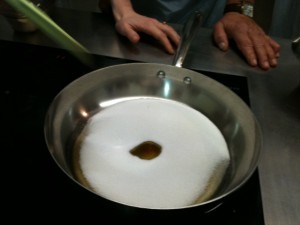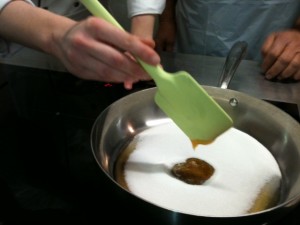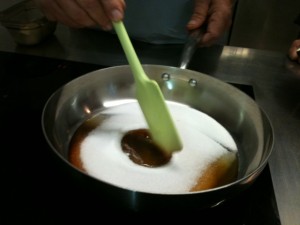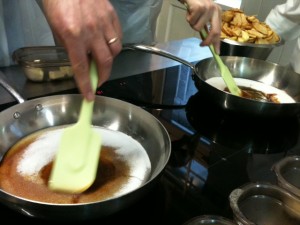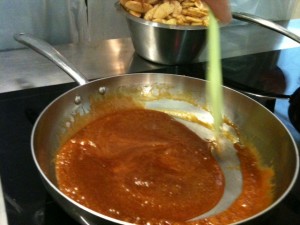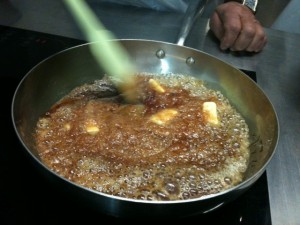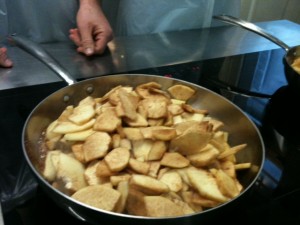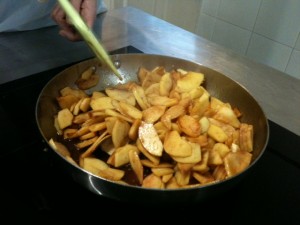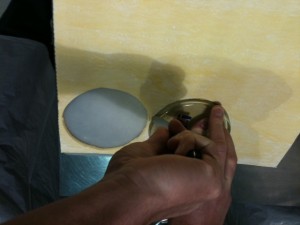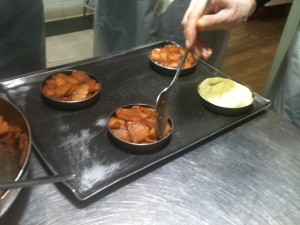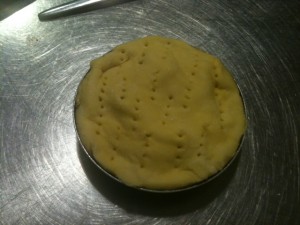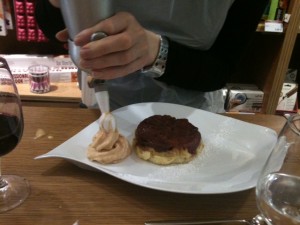The idea of making my own foie gras came to me when I went to a party and the hostess had made her own. It was just the way I like it – mouth-melting. So when Relationnel came home from work one day and said that the Comité d’entreprise* had a special offer for a foie gras cooking class with l’Atelier des Chefs we jumped at the chance! I got off the plane from a exhausting week teaching technical translation in Chennai in India, dropped my luggage and headed over to the Atelier, a little groggy with jet lag.
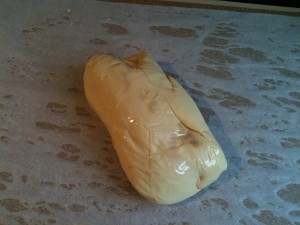 They told us not to take notes, that we’d be given full instructions to go home with us. That was a mistake – it’s taken us about 5 years to fill in the gaps and get it right so this post is definitely a scoop! It was all very fun and interesting though and we got to taste the chef’s foie gras at the end and take home our own creations which lived up to expectations. I’m going to try and describe the process, but I’m not convinced you can really do it without having some sort of demonstration. So I suggest you watch this video by L’Atelier des Chefs even though it’s in French. The second part shows how to cover the foie gras with chocolate, but that’s not in my recipe!
They told us not to take notes, that we’d be given full instructions to go home with us. That was a mistake – it’s taken us about 5 years to fill in the gaps and get it right so this post is definitely a scoop! It was all very fun and interesting though and we got to taste the chef’s foie gras at the end and take home our own creations which lived up to expectations. I’m going to try and describe the process, but I’m not convinced you can really do it without having some sort of demonstration. So I suggest you watch this video by L’Atelier des Chefs even though it’s in French. The second part shows how to cover the foie gras with chocolate, but that’s not in my recipe!
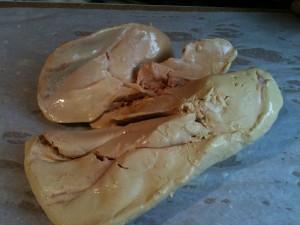 The result mainly depends on the quality of the foie gras itself. A couple of years ago, we bought some Eastern European foie gras on the market – much cheaper – but were very disappointed with the results. Now we ask for “high quality foie gras” from the south west of France at the butcher’s on Rue Montorgueil. It usually weighs 500 to 700 grams. The one I bought this time was 500 grams and cost 30 euros. The same foie gras (mi-cuit) bought from the traiteur costs 110 to 120 euros a kilo, so making your own is definitely more economical.
The result mainly depends on the quality of the foie gras itself. A couple of years ago, we bought some Eastern European foie gras on the market – much cheaper – but were very disappointed with the results. Now we ask for “high quality foie gras” from the south west of France at the butcher’s on Rue Montorgueil. It usually weighs 500 to 700 grams. The one I bought this time was 500 grams and cost 30 euros. The same foie gras (mi-cuit) bought from the traiteur costs 110 to 120 euros a kilo, so making your own is definitely more economical.
It needs to be cooked at least 5 days before you eat it and you need one or two days to make it. The first thing you do is to soak the whole foie gras in a mixture of ½ litre of milk and 10 grams of coarse salt with enough water to cover. You leave it in the fridge overnight or at ambient temperature for 1 ½ hours if you’re pushed for time. Cover the top of the foie gras with greaseproof paper to stop it drying out and take it out about an hour before you use it.
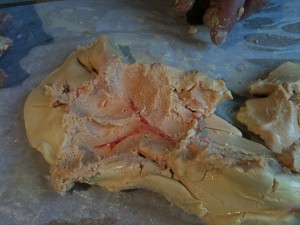 Next day, you get everything ready beforehand because once you’ve got your hands in the foie gras, it’s like having them in butter, only worse. The seasoning is important and very precise : 8 grams per 500 grams of foie gras, consisting of 7 grams of fine salt, ½ gram of freshly-ground pepper and ½ gram of 5-spice mixture (cinnamom, cloves, star anis, fennel and brown peppercorns). Since few people have scales with that type of precision, it’s a good idea to make up a bigger batch and keep it in a screw-top jar. Measure out the 8 grams and put it into a small cup with a coffee spoon.
Next day, you get everything ready beforehand because once you’ve got your hands in the foie gras, it’s like having them in butter, only worse. The seasoning is important and very precise : 8 grams per 500 grams of foie gras, consisting of 7 grams of fine salt, ½ gram of freshly-ground pepper and ½ gram of 5-spice mixture (cinnamom, cloves, star anis, fennel and brown peppercorns). Since few people have scales with that type of precision, it’s a good idea to make up a bigger batch and keep it in a screw-top jar. Measure out the 8 grams and put it into a small cup with a coffee spoon.
Another thing is keeping your hands and the foie gras cold enough. Relationnel (who likes very sophisticated cooking equipment) has a very handy marble plaque that is perfect. You just put it in the fridge for a couple of hours beforehand (this means taking everything off one shelf of course …) or on the balcony if it’s cold enough. You then moisten it slightly and cover with a sheet of greaseproof paper or cling-film (if you feel brave enough) as it makes the foie gras easier to handle and faciltates cleaning up afterwards. Of course, any other flat surface works as well!
You then measure out the white port wine (3 deciliters) into a small cup and add a coffee spoon. Put some iced water into a bowl to dip your fingers in when the foie gras gets too slippery. You can also turn off the heating in the kitchen which I invariably forget to do. Put the terrine (or a small aluminium tray) on the table next to you together with a few pieces of paper towel (to clean your iPhone when you drop it on top of the foie gras you’re trying to photograph) and a sharp pointed knife. Now you’re ready to go!
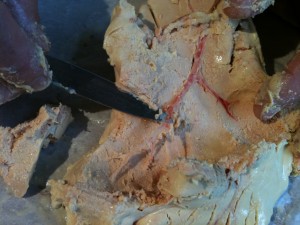 Place the foie gras on the greaseproof paper. Gently separate the two lobes. One is much bigger than the other. Gently open up the big lobe lengthways, sort of running your finger along it. You’ll see a large Y-shaped vein which you have to remove without breaking it. Now the idea is to knead the foie gras underneath to release the vein, lifting the vein very gently with a knife but not cutting it. The foie gras gets completely mashed in the process but that’s normal. After you remove the first vein, you’ll find a second, larger one, underneath. Repeat the process. The second lobe also has two veins, but they are star-shaped this time.
Place the foie gras on the greaseproof paper. Gently separate the two lobes. One is much bigger than the other. Gently open up the big lobe lengthways, sort of running your finger along it. You’ll see a large Y-shaped vein which you have to remove without breaking it. Now the idea is to knead the foie gras underneath to release the vein, lifting the vein very gently with a knife but not cutting it. The foie gras gets completely mashed in the process but that’s normal. After you remove the first vein, you’ll find a second, larger one, underneath. Repeat the process. The second lobe also has two veins, but they are star-shaped this time.
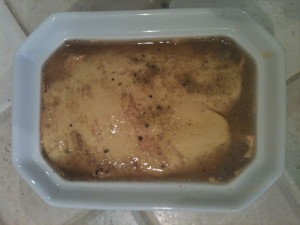 Once the veins have been removed, gather up all the bits and pieces of foie gras and put them back on the lobes. Sprinkle about half the seasoning evenly over the two lobes, then dissolve with about half the port wine. Put the two lobes together like a sandwich then put into the terrine or aluminium tray after sprinkling some more of the seasoning on the bottom. The terrine should be just big enough to take the foie gras. Push down on the top to remove any air, then sprinkle with the rest of the seasoning and port wine. It always seems like a lot to me but it really is just the right amount.
Once the veins have been removed, gather up all the bits and pieces of foie gras and put them back on the lobes. Sprinkle about half the seasoning evenly over the two lobes, then dissolve with about half the port wine. Put the two lobes together like a sandwich then put into the terrine or aluminium tray after sprinkling some more of the seasoning on the bottom. The terrine should be just big enough to take the foie gras. Push down on the top to remove any air, then sprinkle with the rest of the seasoning and port wine. It always seems like a lot to me but it really is just the right amount.
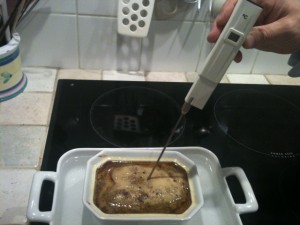 Now is what I consider to be the most delicate part – the cooking. The important thing is getting the core at just the right temperature (the sides are always hotter). You place the terrine or aluminium tray in a larger tray and fill with water and cook for 20 to 25 minutes at 150°C. You can use a thermometer to check when it gets to 37°C (body temperature) but also a skewer, which is less precise of course because you have to judge the temperature yourself. After taking it out the oven you place a press on top (you can make this with a thick piece of cardboard covered in alfoil) and leave at ambient temperature for about 30 minutes. The fat will congeal on top and preserve the foie gras. We then wrap it all in cling wrap to keep it airtight.
Now is what I consider to be the most delicate part – the cooking. The important thing is getting the core at just the right temperature (the sides are always hotter). You place the terrine or aluminium tray in a larger tray and fill with water and cook for 20 to 25 minutes at 150°C. You can use a thermometer to check when it gets to 37°C (body temperature) but also a skewer, which is less precise of course because you have to judge the temperature yourself. After taking it out the oven you place a press on top (you can make this with a thick piece of cardboard covered in alfoil) and leave at ambient temperature for about 30 minutes. The fat will congeal on top and preserve the foie gras. We then wrap it all in cling wrap to keep it airtight.
Enjoy!
Recipe:
One 500 g lobe of foie gras
7 g salt
1/2 g of freshly ground pepper
1/2 g of five spices
3 centiliters of white port wine
Cooking time: 150°C for 20 to 25 minutes.
*Companies with over 50 employees in France have to set up a « works committee » with staff representatives and pay a subsidy at least equal to 0.2% of the wages bill. Depending on the size of the company, employees can then benefit from various lurks and perks such as reductions on holiday accommodation, wine-tasting courses and cooking classes!
L’Atelier des Chefs: http://www.atelierdeschefs.fr/

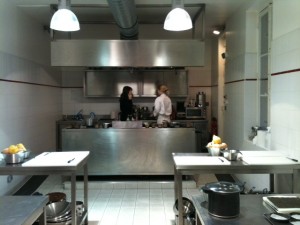 Last Christmas (not the one that’s just been), Black Cat and Leonardo gave us a voucher for a cooking class at L’Atelier des Chefs in Paris where we learnt to make foie gras a few years ago. We kept putting it off until it was nearly too late (the deadline was 31st December) but finally chose a class and booked it, only to be told two days beforehand that it was cancelled! We got an extension for a month and chose another class in January: foie gras maki, fillet of duck with butternut pumpkin purée and tarte tatin with quinces (this is a very popular and typical French upside-down cake usually made with apples).
Last Christmas (not the one that’s just been), Black Cat and Leonardo gave us a voucher for a cooking class at L’Atelier des Chefs in Paris where we learnt to make foie gras a few years ago. We kept putting it off until it was nearly too late (the deadline was 31st December) but finally chose a class and booked it, only to be told two days beforehand that it was cancelled! We got an extension for a month and chose another class in January: foie gras maki, fillet of duck with butternut pumpkin purée and tarte tatin with quinces (this is a very popular and typical French upside-down cake usually made with apples).



